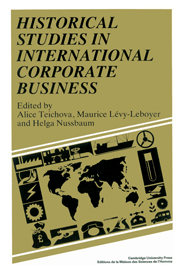Book contents
- Frontmatter
- Contents
- Preface
- 1 Introduction: multinational enterprise
- 2 History, the social sciences and economic ‘theory’, with special reference to multinational enterprise
- 3 The changing form of multinational enterprise expansion in the twentieth century
- 4 Electrical research, standardisation and the beginnings of the corporate economy
- 5 The nature of multinationals, 1870–1939
- 6 International price maintenance: control of commodity trade in the 1920s
- 7 Financial operations of US transnational corporations: development after the Second World War and recent tendencies
- 8 Multinational enterprise – financing, trade, diplomacy: the Swedish case
- 9 Foreign penetration of German enterprises after the First World War: the problem of Überfremdung
- 10 International industrial cartels, the state and politics: Great Britain between the wars
- 11 Vickers and Schneider: a comparison of new British and French multinational strategies 1916–26
- 12 J. & P. Coats Ltd in Poland
- 13 Multinationals and the French electrical industry, 1889–1940
- 14 The Japanese cotton spinners' direct investments into China before the Second World War
- 15 Mitsui Bussan during the 1920s
- 16 Japanese business in the United States before the Second World War: the case of Mitsui and Mitsubishi
- 17 The state and private enterprise in the United States–Latin American oil policy
- 18 Transnational corporations and the denationalization of the Latin American cigarette industry
- 19 Summary: Reflections on the papers and the debate on multinational enterprise: international finance, markets and governments in the twentieth century
- Index of names
- Index of firms
- Index of subjects
13 - Multinationals and the French electrical industry, 1889–1940
Published online by Cambridge University Press: 04 August 2010
- Frontmatter
- Contents
- Preface
- 1 Introduction: multinational enterprise
- 2 History, the social sciences and economic ‘theory’, with special reference to multinational enterprise
- 3 The changing form of multinational enterprise expansion in the twentieth century
- 4 Electrical research, standardisation and the beginnings of the corporate economy
- 5 The nature of multinationals, 1870–1939
- 6 International price maintenance: control of commodity trade in the 1920s
- 7 Financial operations of US transnational corporations: development after the Second World War and recent tendencies
- 8 Multinational enterprise – financing, trade, diplomacy: the Swedish case
- 9 Foreign penetration of German enterprises after the First World War: the problem of Überfremdung
- 10 International industrial cartels, the state and politics: Great Britain between the wars
- 11 Vickers and Schneider: a comparison of new British and French multinational strategies 1916–26
- 12 J. & P. Coats Ltd in Poland
- 13 Multinationals and the French electrical industry, 1889–1940
- 14 The Japanese cotton spinners' direct investments into China before the Second World War
- 15 Mitsui Bussan during the 1920s
- 16 Japanese business in the United States before the Second World War: the case of Mitsui and Mitsubishi
- 17 The state and private enterprise in the United States–Latin American oil policy
- 18 Transnational corporations and the denationalization of the Latin American cigarette industry
- 19 Summary: Reflections on the papers and the debate on multinational enterprise: international finance, markets and governments in the twentieth century
- Index of names
- Index of firms
- Index of subjects
Summary
The part played by multinational companies in a country's economy is often described in terms of dependence. If a nation is experiencing growth difficulties and has a weak market, almost inevitably that nation opens its doors to foreign companies, which, once they gain a foothold, tighten their grip. At first sight, this situation can be fairly convincingly applied to the French electricity industry. For France, in fact, had to rely on patents and capital from international groups in order to launch and maintain this sector. But a deeper analysis is needed, since these generalisations ignore the attitude of French business generally and attribute to all multinationals the same intentions and power, whereas there are important differences between them.
1880–1919: three waves of foreign investment
The French electricity industry was characterised by foreign investment. There was an American presence – most notably through the agencies of the Compagnie Continental Edison (CCE), Thomson–Houston and S. A. Westinghouse. The Swiss operated in France through Alioth and a French company – Compagnie Electro-Mécanique (CEM) – re-acquired by Brown Boveri. The German participation, although smaller, was felt mainly through the Société Française AEG and the Société d'Electricité de Creil. Empain, Ericsson and Philips also owned French subsidiaries. But this sizeable foreign involvement in electricity did not necessarily imply domination of it. The earlier multinational companies arrived in France, the more they had to rely substantially on local assistance.
- Type
- Chapter
- Information
- Historical Studies in International Corporate Business , pp. 143 - 150Publisher: Cambridge University PressPrint publication year: 1989



